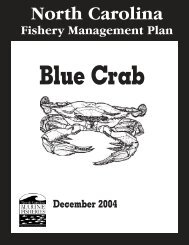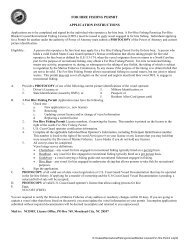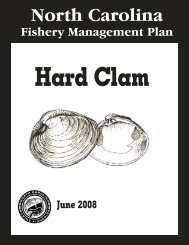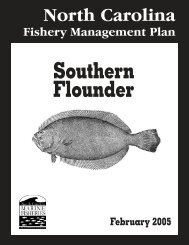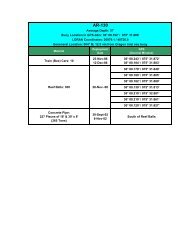- Page 5 and 6: 9.1.4 Characterization of the Bait
- Page 7 and 8: estoration are essential to accompl
- Page 9 and 10: . Recommend management actions pert
- Page 11 and 12: 4.4.1 Environmental degradationSuit
- Page 13 and 14: History Note: Authority G.S. 113-13
- Page 15 and 16: 76° 28.6000' W; to a point at 34°
- Page 17 and 18: times specified for the identified
- Page 19 and 20: 5. STATUS OF STOCK5.1 GENERAL LIFE
- Page 21 and 22: microalgae, phytoplankton and zoopl
- Page 23 and 24: North Carolina spans September to M
- Page 25 and 26: 200 mm FL [Leard et al. 1995 (Appen
- Page 27 and 28: Young-of-the-year and Juvenile Move
- Page 29 and 30: surveys provided indices of adult C
- Page 31 and 32: 6. STATUS OF FISHERIES6.1 COMMERCIA
- Page 33 and 34: adjusted for inflationValue of the
- Page 35 and 36: a.GSI151050Jan Feb Mar Apr May Jun
- Page 37 and 38: 6.1.6 Primary Waterbodies of Harves
- Page 39 and 40: 25,000No. Trips% of Total Landings0
- Page 41: 6.1.9 Major gear types used in the
- Page 45 and 46: 40%Pamlico S. Neuse R. Core S.Inlan
- Page 47 and 48: Landings (lb)1,400,0001,200,0001,00
- Page 49 and 50: movement of schooling fish so that
- Page 51 and 52: Landings (lb)45,00040,00035,00030,0
- Page 53 and 54: Table 6.6.Number of mullets (stripe
- Page 55 and 56: Table 6.8.Estimated catch statistic
- Page 57 and 58: ex-vessel prices began to drop due
- Page 59 and 60: 60%50%43%48%40%Percent30%20%10%0%Gi
- Page 61 and 62: 7.2.3 Marketing, Distribution, and
- Page 63 and 64: (RCGL) who are licensed to use limi
- Page 65 and 66: trip where striped mullet were land
- Page 67 and 68: didn’t fish all year, fishing act
- Page 69 and 70: 8. ENVIRONMENTAL FACTORS8.1 HABITAT
- Page 71 and 72: Seagrass meadows are a complex ecos
- Page 73 and 74: early 1980s (Khalil 1997).Oxygen De
- Page 75 and 76: fish, (2) Season for taking fish, a
- Page 77 and 78: 9. PRINCIPAL ISSUES AND MANAGEMENT
- Page 79 and 80: enhance protection of water quality
- Page 81 and 82: ecreational gill netting of adult f
- Page 83 and 84: 9.1.8 Management Implications of Pr
- Page 85 and 86: 6. Annual review of commercial and
- Page 87 and 88: Blanton, J. O., F. E. Werner, A. Ka
- Page 89 and 90: Foster, J.R. 2001. Data analysis su
- Page 91 and 92: Mahmoudi, B., Foushee, L., McGlothi
- Page 93 and 94:
Pattillo, M.E., Czapla, T.E., Nelso
- Page 95 and 96:
Taylor, H. F. 1951. Survey of marin
- Page 97 and 98:
11. APPENDICES11.1 Appendix 1 GLOSS
- Page 99 and 100:
Table 2. Size at annuli formation (
- Page 101 and 102:
11.2 Appendix 2 BYCATCH ASSESSMENT
- Page 103 and 104:
have mandatory observer coverage fo
- Page 105 and 106:
the Pamlico, Pungo, and Neuse River
- Page 107 and 108:
and 2002 were quantified based upon
- Page 109 and 110:
sets. These were caught in Outer Ba
- Page 111 and 112:
Fishery-dependent and fishery-indep
- Page 113 and 114:
Table 3.Comparison of striped mulle
- Page 115 and 116:
Unmarketable bycatchIn 1999 and 200
- Page 117 and 118:
SECTION .0100 - NET RULES, GENERAL.
- Page 119 and 120:
11.3 Appendix 3 CHARACTERIZATION OF
- Page 121 and 122:
100%Striped MulletWhite Mullet90%87
- Page 123 and 124:
Table 1.Number and weight of stripe
- Page 125 and 126:
The fall commercial cast net landin
- Page 127 and 128:
2. Minimum size limit+ Reduced harv
- Page 129 and 130:
Advisory Committee Recommendation:T
- Page 131 and 132:
21.81.6FcurrentF25% = 1.25F30% = 0.
- Page 133 and 134:
Limited EntryA limited entry system
- Page 135 and 136:
and in fisheries targeting perches
- Page 137 and 138:
Fran and Floyd likely depressed lan
- Page 139 and 140:
3. Implementation of Regulationsa.
- Page 141 and 142:
11.5 Appendix 5 PIER, STOP NET AND
- Page 143 and 144:
distance can be established to sepa
- Page 145 and 146:
11.6 Appendix 6 INSHORE STRIPED MUL
- Page 147 and 148:
2. Adopt 24 hour, 365 day per year
- Page 149 and 150:
III.DISCUSSIONIn 1994, the DMF impl
- Page 151 and 152:
- contentious relations with NMFS o
- Page 153 and 154:
Fisheries by proclamation, shall be
- Page 155 and 156:
Supplement 2. North Carolina Marine
- Page 157 and 158:
mesh webbing to capture monkfish in
- Page 159 and 160:
12. ATTACHMENTS12.1 Attachment 1. P
- Page 161 and 162:
data were used for defining F-based
- Page 163 and 164:
stock. The stock has been recognize
- Page 165 and 166:
Table 1.Von Bertalanffy growth para
- Page 167 and 168:
Length-Weight RelationshipA linear,
- Page 169 and 170:
Table 2.Various instantaneous natur
- Page 171 and 172:
age using DMF male and female age-l
- Page 173 and 174:
affected by schooling artifacts and
- Page 175 and 176:
whereas age 0 fish comprise the bul
- Page 177 and 178:
Alosid Seine Survey CPUEStandard Er
- Page 179 and 180:
Table 12. Annual length composition
- Page 181 and 182:
growth, longevity, and harvest char
- Page 183 and 184:
Table 15. Model-estimated von Berta
- Page 185 and 186:
Selectivity .1.00.80.60.40.20.0Age
- Page 187 and 188:
Table 20. Age specific commercial f
- Page 189 and 190:
Table 23. Full year, commercial + r
- Page 191 and 192:
assessment, peaking in 2002 (Figure
- Page 193 and 194:
Fishing Mortality (F)2.01.51.00.50.
- Page 195 and 196:
low, and F high were based on histo
- Page 197 and 198:
Discussion:Age-growthThe growth cur
- Page 199 and 200:
6+ females between 1994-2002.Overfi
- Page 201 and 202:
assessment, as overfishing occurred
- Page 203 and 204:
The future economics of the roe fis
- Page 205 and 206:
References CitedAlagaraja, K. 1984.
- Page 207:
McGurk, M.D. 1999. Size dependent m




